Milwaukee 2725-20 Handleiding
Milwaukee
Grastrimmer
2725-20
Bekijk gratis de handleiding van Milwaukee 2725-20 (20 pagina’s), behorend tot de categorie Grastrimmer. Deze gids werd als nuttig beoordeeld door 41 mensen en kreeg gemiddeld 4.2 sterren uit 21 reviews. Heb je een vraag over Milwaukee 2725-20 of wil je andere gebruikers van dit product iets vragen? Stel een vraag
Pagina 1/20

Cat. No. / No de cat.
2725-20
M18 FUEL™ STRING TRIMMER
TAILLE-BORDURES M18 FUEL™
BORDEADORA DE HILO M18 FUEL™
OPERATOR'S MANUAL
MANUEL de L'UTILISATEUR
MANUAL del OPERADOR
WARNING To reduce the risk of injury, user must read and understand operator's manual.
AVERTISSEMENT An de réduire le risque de blessures, l'utilisateur doit lire et bien
comprendre le manuel.
ADVERTENCIA Para reducir el riesgo de lesiones, el usuario debe leer y entender el manual.

2
IMPORTANT SAFETY
INSTRUCTIONS
WARNING
Read all safety warnings, instruc-
tions, illustrations and specica-
tions provided with this power tool. Failure to follow
all instructions listed below may result in electric shock,
re and/or serious injury. Save all warnings and in-
structions for future reference.
READ ALL INSTRUCTIONS
BEFORE USE
WORK AREA SAFETY
• Keep work area clean and well lit. Cluttered or
dark areas invite accidents.
• Do not operate power tools in explosive atmo-
spheres, such as in the presence of ammable
liquids, gases or dust. Power tools create sparks
which may ignite the dust or fumes.
• Keep children and bystanders away while operat-
ing a power tool. Distractions can cause you to lose
control.
• Do not allow to be used as a toy. Close attention
is necessary when used by or near children.
Store idle power tools out of the reach of chil-
dren and do not allow persons unfamiliar with
the power tool or these instructions to operate
the power tool. Power tools are dangerous in the
hands of untrained users.
• Do not use the tool near anything that is burning or
smoking such as cigarettes, matches, or hot ashes.
•To reduce the risk of health hazards from vapors
or dust, do not use tool near tool toxic, carcino-
genic or other hazardous materials such as as-
bestos, arsenic, barium, beryllium, lead, pesticides
or other health endangering materials.
ELECTRICAL SAFETY
• Do not expose power tools to rain or wet condi-
tions. Do not immerse in water or spray with a
hose. Do not clean with a pressure washer. Water
entering a power tool will increase the risk of electric
shock. Store tool indoors.
PERSONAL SAFETY
• Stay alert, watch what you are doing and use
common sense when operating a power tool. Do
not use a power tool while you are tired or under
the inuence of drugs, alcohol or medication. A
moment of inattention while operating power tools
may result in serious personal injury.
•Always wear eye protection. Use of this tool can
result in foreign objects being thrown into eyes,
which can result in eye damage.
•Wear a face or dust mask when working in dust
situations. Dust particles can harm your lungs.
• Use personal protective equipment. Protective
equipment such as hearing protection, protective
clothing, and non-skid safety shoes used for ap-
propriate conditions will reduce personal injuries.
• Dress properly. Do not wear loose clothing or
jewelry. Keep your hair and clothing away from
moving parts. Loose clothes, jewelry or long hair
can be caught in moving parts.
• Do not overreach. Keep proper footing and bal-
ance at all times. This enables better control of the
power tool in unexpected situations.
• Use the power tool, accessories, etc. in ac-
cordance with these instructions, taking into
account the working conditions and the work
to be performed. Use of the power tool for opera-
tions dierent from those intended could result in a
hazardous situation.
• Prevent unintentional starting. Ensure the switch
is in the o-position before connecting to power
source and/or battery pack, picking up or carrying
the tool. Carrying power tools with your nger on
the switch or energizing power tools that have the
switch on invites accidents.
• Do not let familiarity gained from frequent use
of tools allow you to become complacent and
ignore tool safety principles. A careless action can
cause severe injury within a fraction of a second.
POWER TOOL USE AND CARE
• Do not force the power tool. Use the correct
power tool for your application. The correct power
tool will do the job better and safer at the rate for
which it was designed.
• Use tool only as described in this manual. Use
only manufacturer’s recommended attachments.
• Do not use the power tool if the switch does not
turn it on and o. Any power tool that cannot be
controlled with the switch is dangerous and must be
repaired.
• Disconnect the plug from the power source and/
or remove the battery pack, if detachable, from
the power tool before making any adjustments,
changing accessories, or storing power tools.
Such preventive safety measures reduce the risk of
starting the power tool accidentally.
• Store idle power tools out of the reach of children
and do not allow persons unfamiliar with the
power tool or these instructions to operate the
power tool. Power tools are dangerous in the hands
of untrained users.
• Do not store the power tool on or near to fertilizers
or chemicals.
• Maintain power tools and accessories. Check
for misalignment or binding of moving parts,
breakage of parts and any other condition that
may aect the power tool’s operation. If damaged,
have the power tool repaired before use. Many
accidents are caused by poorly maintained power
tools.
• Use the power tool, accessories, etc. in ac-
cordance with these instructions, taking into
account the working conditions and the work
to be performed. Use of the power tool for opera-
tions dierent from those intended could result in a
hazardous situation.
• Keep handles and grasping surfaces dry, clean
and free from oil and grease. Slippery handles and
grasping surfaces do not allow for safe handling and
control of the tool in unexpected situations.
BATTERY TOOL USE AND CARE
• Remove the battery pack from the power tool
before making any adjustments, changing ac-
cessories, storing, or any time the power tool is
not in use. Such preventive safety measures reduce
the risk of starting the power tool accidentally.

3
•Turn o power tool before removing battery
pack.
• Do not handle battery pack, tool, or charger
(including charger plug and terminals) with wet
hands.
•Before using the battery pack or charger read
the operator’s manuals, and any labels on the
battery pack, charger and tool.
• Recharge only with the charger specied by the
manufacturer. A charger that is suitable for one type
of battery pack may create a risk of re when used
with another battery pack.
• Use power tools only with specically designated
battery packs. Use of any other battery packs may
create a risk of injury and re.
• When battery pack is not in use, keep it away
from other metal objects, like paper clips, coins,
keys, nails, screws or other small metal objects,
that can make a connection from one terminal
to another. Shorting the battery terminals together
may cause burns or a re.
• Under abusive conditions, liquid may be ejected
from the battery; avoid contact. If contact ac-
cidentally occurs, flush with water. If liquid
contacts eyes, additionally seek medical help.
Liquid ejected from the battery may cause irritation
or burns.
• Do not use a battery pack or tool that is dam-
aged or modied. Damaged or modied batteries
may exhibit unpredictable behavior resulting in re,
explosion or risk of injury.
• Do not expose a battery pack or tool to re or
excessive temperature. Exposure to re or tem-
perature above 265°F (130°C) may cause explosion.
• Follow all charging instructions and do not charge
the battery pack or tool outside the temperature
range specied in the instructions. Charging
improperly or at temperatures outside the specied
range may damage the battery and increase the risk
of re.
SERVICE
• Have your power tool serviced by a qualied
repair person using only identical replacement
parts. This will ensure that the safety of the power
tool is maintained.
• Never service damaged battery packs. Service
of battery packs should only be performed by the
manufacturer or authorized service providers.
SPECIFIC SAFETY RULES FOR
STRING TRIMMERS
• Keep bystanders at least 50' away during use.
Objects may be thrown or ricochet in all directions.
•Brace for unexpected movement when contact
is made with a hard object. Loss of control could
result in serious injury.
•Do not use blades, brush cutting wheels,
accessories, or attachment other than those
recommended by MILWAUKEE. Serious injury or
product damage may occur.
• Do not operate the tool without the guard in
place. The guard must be attached properly
when trimming. Operating the trimmer without the
guard will cause serious injury.
• Do not use tool with a damaged trimmer head.
Cracked or broken pieces can be thrown.
•Do not operate the tool without the front handle
in place. The front handle must be attached
properly for use when trimming. Using one hand
could cause loss of control and result in serious injury.
• Carry the trimmer by the front handle. Proper
handling of the trimmer will prevent injury.
•Use both hands when operating the trimmer.
Maintain a rm grip. Using one hand could cause
loss of control and result in serious injury.
• Inspect the area before using the tool. Remove
all debris and hard objects such as rocks, glass,
wire, etc. that can ricochet, be thrown, or otherwise
cause injury or damage during operation.
•Keep face, hands and feet clear of rotating line at
all times. Rotating line can cause severe lacerations.
• Thrown objects may ricochet o of hard surfaces,
such as walls, trees, and rocks and cause injury.
When possible, do trimming by hand in closed in
areas.
•When replacing the line, use only .080" monola-
ment or .095" braided (2 mm or 2.4 mm) diameter
line. Any other size can degrade performance or
cause damage to the trimmer.
•Use care when trimming around decorative plants
and other obstacles. Rotating line will cut/damage
many materials.
• Always turn o the tool between cuts or when
transporting from one location to another. Do
not carry tool with nger on the trigger. Accidental
starting can cause serious personal injury.
• Do not use tool as an edger. Do not tilt tool to
create a right angle to the ground. Keep trimmer
head and line parallel to the ground. Guard cannot
protect against ying debris in this orientation.
• Always use common sense and be cautious when
using tools. It is not possible to anticipate every
situation that could result in a dangerous outcome.
Do not use this tool if you do not understand these
operating instructions or you feel the work is beyond
your capability; contact Milwaukee Tool or a trained
professional for additional information or training.
• Maintain labels and nameplates. These carry
important information. If unreadable or missing,
contact a MILWAUKEE service facility for a free
replacement.
•
WARNING
Some dust created by power sanding,
sawing, grinding, drilling, and other
construction activities contains chemicals known to
cause cancer, birth defects or other reproductive
harm. Some examples of these chemicals are:
• lead from lead-based paint
• crystalline silica from bricks and cement and other
masonry products, and
• arsenic and chromium from chemically-treated
lumber.
Your risk from these exposures varies, depending on
how often you do this type of work. To reduce your
exposure to these chemicals: work in a well ventilated
area, and work with approved safety equipment, such
as those dust masks that are specially designed to
lter out microscopic particles.
READ AND SAVE ALL
INSTRUCTIONS FOR
FUTURE USE
Product specificaties
| Merk: | Milwaukee |
| Categorie: | Grastrimmer |
| Model: | 2725-20 |
Heb je hulp nodig?
Als je hulp nodig hebt met Milwaukee 2725-20 stel dan hieronder een vraag en andere gebruikers zullen je antwoorden
Handleiding Grastrimmer Milwaukee
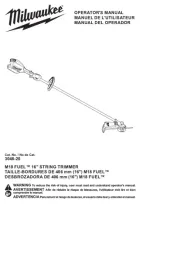
14 Juli 2025

2 Mei 2023

11 April 2023

8 Februari 2023

25 Oktober 2022
Handleiding Grastrimmer
- Yard Force
- Powerworks
- Kraftixx
- Gardena
- Solo
- MacAllister
- Innoliving
- Meec Tools
- OK
- McCulloch
- Qualcast
- Silverline
- Ferm
- Adler
- Philips
Nieuwste handleidingen voor Grastrimmer
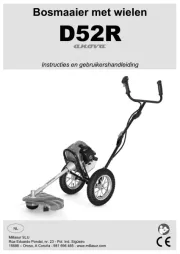
10 September 2025
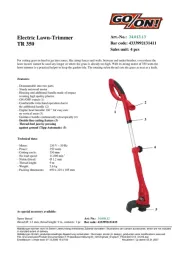
8 September 2025
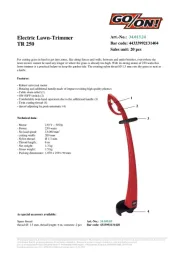
7 September 2025
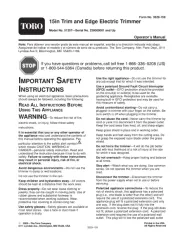
2 September 2025
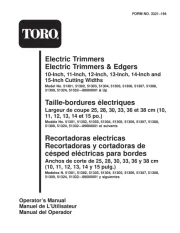
2 September 2025
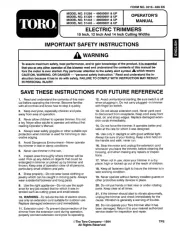
2 September 2025
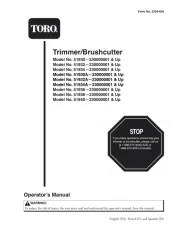
2 September 2025
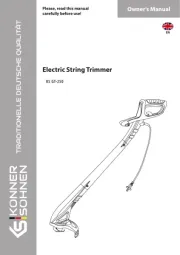
2 September 2025
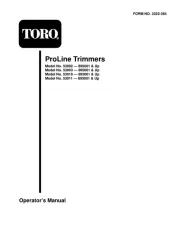
2 September 2025
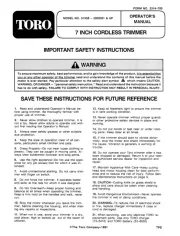
2 September 2025